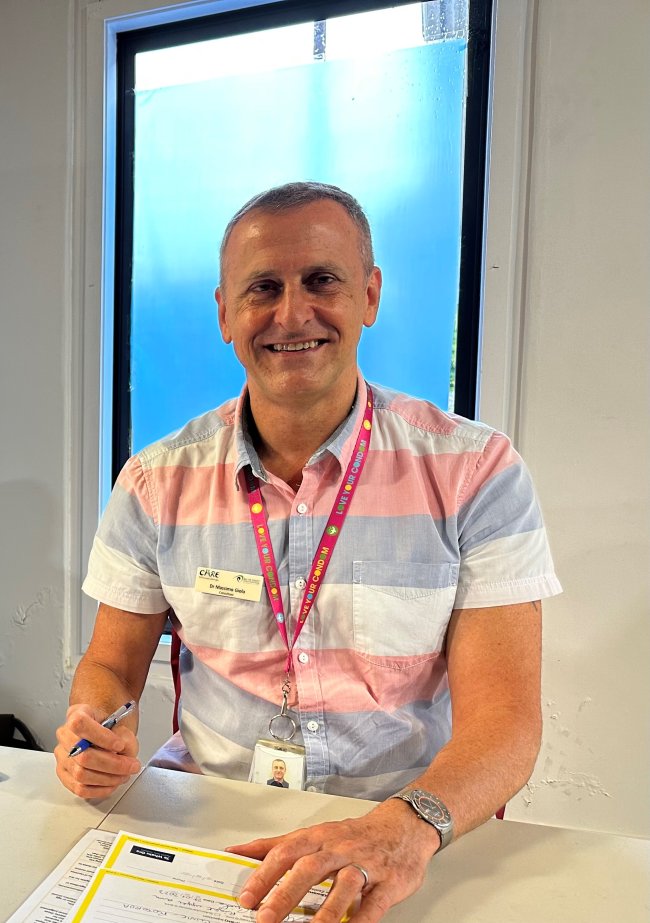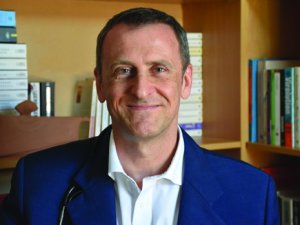Respiratory physician Lutz Beckert considers chronic obstructive pulmonary disease management, including the prevention of COPD, the importance of smoking cessation and pulmonary rehabilitation, and the lifesaving potential of addressing treatable traits. He also discusses the logic of inhaler therapy, moving from single therapy to dual and triple therapy when indicated, as well as other aspects of management
Optimism on HIV plan to eliminate local transmission
Optimism on HIV plan to eliminate local transmission
“$18 million could be too little or it could amount to something. It is a good starting amount”
The HIV action plan is well equipped to eliminate transmission – but it depends on where the money is spent, sexual health physician Massimo Giola says.
A “roadmap” aimed at reducing local transmission and ensuring people can live healthy lives with HIV, the National HIV Action Plan for Aotearoa New Zealand 2022–2032 was released this month by the Ministry of Health.
Dr Giola, a member of the New Zealand Sexual Health Society, says creating the plan was “the easy part” and the challenge is to ensure the associated funding is spent “intentionally” rather than being spread too thinly.
Budget 2022 allocated $18 million for the first four years implementing the plan, on top of $5 million for HIV prevention and surveillance already spent annually.
“$18 million could be too little or it could amount to something – it is a good starting amount," says Dr Giola, one of the experts consulted in developing the plan.
The plan does not specify where the funds will be spent, he points out.
Dr Giola says his top two priorities would be to fund pre-exposure prophylaxis (PrEP) for all and to instruct Pharmac to buy more contemporary medication for people living with HIV.
PrEP is free to access for anyone eligible for publicly funded healthcare. But Dr Giola says this excludes people coming from overseas who are potentially at risk of HIV.
“PrEP is a public health tool, it is necessary to keep everyone safe, and people should not be required to pay,” he says.
For people living with HIV, only one combination tablet is funded, he says, and it is “not the most contemporary drug out there”. Australia has funded the latest HIV medications for eight years.
Dr Giola says he hopes once the $18 million is spent, Te Whatu Ora will build more funds into its normal spending.
Dr Giola says he feels enthusiastic about the plan, against which to “the people holding the purse-strings” – that is, Te Whatu Ora, Te Aka Whai Ora and the Public Health Agency – can be held accountable.
The goals of the plan are to:
- reduce the number of new and locally acquired HIV infections
- improve Māori health and wellbeing in relation to HIV by delivering on our Te Tiriti o Waitangi obligations
- decrease mortality and negative consequences of HIV on health and wellbeing
- decrease experiences of stigma and discrimination for people living with HIV, and
- increase equity in relation to all HIV goals and objectives.
“These objectives are absolutely deliverable by 2030. They are definitely within our reach.”
HIV prevention and treatment understandably draws the largest chunk of attention compared with other sexually transmitted infections of concern because of its history of global devastation, Dr Giola says. But he is more concerned about the rise in transmission of syphilis, gonorrhoea and hepatitis C.
A 41 per cent increase in syphilis cases in the second half of 2022 was reported by the ministry and ESR in a media release last week.
The peak of HIV cases in Aotearoa New Zealand occurred in 2016, and it has been steadily declining since then. Experts are keeping a keen eye out for a post-COVID-19 rebound, but so far that hasn’t happened, says Dr Giola, who was also involved the STI reduction strategy released this month.
Ngā Pokenga Paipai me Ngā Pokenga Huaketo mā te Toto: Te Rautaki o Aotearoa – The Sexually Transmitted and Blood Borne Infection Strategy is the “umbrella” to all strategies and action plans for individual STIs.
He suggests there is likely more stigma around syphilis and other STIs because they have not had as big public health campaigns.
“People who have STIs (other than HIV) do not feel that same need to speak on their experience, so it’s hard to find advocates,” he says.
He urges practitioners to advocate on behalf of their patients and says advocacy training should be a part of general practice education.
“Second to sexual health specialists, GPs have the best understanding of the need for advocacy on STIs,” but this needs to be encouraged further, he says.
“Big cultural changes” are needed, he says, and all health workers need to normalise safe sex more to lessen the stigma.
Gay, bisexual, and men who have sex with men are 500 times more likely to contract gonorrhoea than the general population.
Māori and Pacific people are affected by STIs at four to five times the rate of the general population, so are also a focus.
Other groups such as people under 25, sex workers and those who inject drugs also face inequitable HIV harm and are targeted in the action plan.
We're publishing this article as a FREE READ so it is FREE to read and EASY to share more widely. Please support us and the hard work of our journalists by clicking here and subscribing to our publication and website







![Barbara Fountain, editor of New Zealand Doctor Rata Aotearoa, and Paul Hutchison, GP and senior medical clinician at Tāmaki Health [Image: Simon Maude]](/sites/default/files/styles/thumbnail_cropped_100/public/2025-03/Barbara%20Fountain%2C%20editor%20of%20New%20Zealand%20Doctor%20Rata%20Aotearoa%2C%20and%20Paul%20Hutchison%2C%20GP%20and%20senior%20medical%20clinician%20at%20T%C4%81maki%20Health%20CR%20Simon%20Maude.jpg?itok=-HbQ1EYA)
![Lori Peters, NP and advanced health improvement practitioner at Mahitahi Hauora, and Jasper Nacilla, NP at The Terrace Medical Centre in Wellington [Image: Simon Maude]](/sites/default/files/styles/thumbnail_cropped_100/public/2025-03/2.%20Lori%20Peters%2C%20NP%20and%20advanced%20HIP%20at%20Mahitahi%20Hauora%2C%20and%20Jasper%20Nacilla%2C%20NP%20at%20The%20Terrace%20Medical%20Centre%20in%20Wellington%20CR%20Simon%20Maude.jpg?itok=sUfbsSF1)
![Ministry of Social Development health and disability coordinator Liz Williams, regional health advisors Mary Mojel and Larah Takarangi, and health and disability coordinators Rebecca Staunton and Myint Than Htut [Image: Simon Maude]](/sites/default/files/styles/thumbnail_cropped_100/public/2025-03/3.%20Ministry%20of%20Social%20Development%27s%20Liz%20Williams%2C%20Mary%20Mojel%2C%20Larah%20Takarangi%2C%20Rebecca%20Staunton%20and%20Myint%20Than%20Htut%20CR%20Simon%20Maude.jpg?itok=9ceOujzC)
![Locum GP Helen Fisher, with Te Kuiti Medical Centre NP Bridget Woodney [Image: Simon Maude]](/sites/default/files/styles/thumbnail_cropped_100/public/2025-03/4.%20Locum%20GP%20Helen%20Fisher%2C%20with%20Te%20Kuiti%20Medical%20Centre%20NP%20Bridget%20Woodney%20CR%20Simon%20Maude.jpg?itok=TJeODetm)
![Ruby Faulkner, GPEP2, with David Small, GPEP3 from The Doctors Greenmeadows in Napier [Image: Simon Maude]](/sites/default/files/styles/thumbnail_cropped_100/public/2025-03/5.%20Ruby%20Faulkner%2C%20GPEP2%2C%20with%20David%20Small%2C%20GPEP3%20from%20The%20Doctors%20Greenmeadows%20in%20Napier%20CR%20Simon%20Maude.jpg?itok=B0u4wsIs)
![Rochelle Langton and Libby Thomas, marketing advisors at the Medical Protection Society [Image: Simon Maude]](/sites/default/files/styles/thumbnail_cropped_100/public/2025-03/6.%20Rochelle%20Langton%20and%20Libby%20Thomas%2C%20marketing%20advisors%20at%20the%20Medical%20Protection%20Society%20CR%20Simon%20Maude.jpg?itok=r52_Cf74)
![Specialist GP Lucy Gibberd, medical advisor at MPS, and Zara Bolam, urgent-care specialist at The Nest Health Centre in Inglewood [Image: Simon Maude]](/sites/default/files/styles/thumbnail_cropped_100/public/2025-03/7.%20Specialist%20GP%20Lucy%20Gibberd%2C%20medical%20advisor%20at%20MPS%2C%20and%20Zara%20Bolam%2C%20urgent-care%20specialist%20at%20The%20Nest%20Health%20Centre%20in%20Inglewood%20CR%20Simon%20Maude.jpg?itok=z8eVoBU3)
![Olivia Blackmore and Trudee Sharp, NPs at Gore Health Centre, and Gaylene Hastie, NP at Queenstown Medical Centre [Image: Simon Maude]](/sites/default/files/styles/thumbnail_cropped_100/public/2025-03/8.%20Olivia%20Blackmore%20and%20Trudee%20Sharp%2C%20NPs%20at%20Gore%20Health%20Centre%2C%20and%20Gaylene%20Hastie%2C%20NP%20at%20Queenstown%20Medical%20Centre%20CR%20Simon%20Maude.jpg?itok=Z6u9d0XH)
![Mary Toloa, specialist GP at Porirua and Union Community Health Service in Wellington, Mara Coler, clinical pharmacist at Tū Ora Compass Health, and Bhavna Mistry, specialist GP at Porirua and Union Community Health Service [Image: Simon Maude]](/sites/default/files/styles/thumbnail_cropped_100/public/2025-03/9.%20Mary%20Toloa%2C%20Porirua%20and%20Union%20Community%20Health%20Service%20in%20Wellington%2C%20Mara%20Coler%2C%20T%C5%AB%20Ora%20Compass%20Health%2C%20and%20Bhavna%20Mistry%2C%20PUCHS%20CR%20Simon%20Maude.jpg?itok=kpChr0cc)